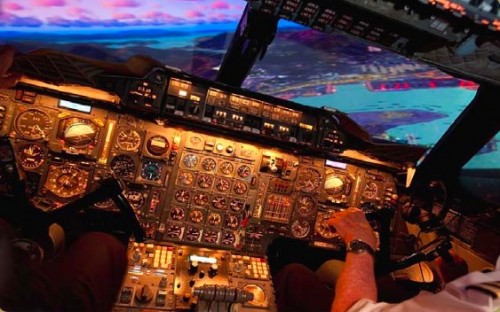
There is an airline grade simulator for the Concorde supersonic transport, located in the UK and available to the public, with instruction by former Concorde flight crew members.
The simulator was originally built in 1975 as a full-motion simulator, with the “motion” part provided by six hydraulic rams. The view out the cockpit windows was created by moving a television camera over a large model landscape in an adjacent room. I’m not sure whether the flight dynamics calculations were done by analog, digital, or a combination of both methods. In 1987, the simulator was upgraded to replace the TV camera and the physical map with computer-generated imagery. Original cost of the simulator was £3 million, and the 1987 upgrade cost an additional £3 million.
When Concord operations ceased in 2003, the simulator was decommissioned and re-installed at the Brooklands Museum, minus the hydraulic actuators for the motion feature. (“enabling access to a Concorde cockpit for less able visitors to the museum” is the reason stated for this decision, but I would imagine it also had something to do with the maintenance costs for the hydraulics.) The restoration of the simulator involved the replacement of whatever electronic systems were doing the computations with modern flight simulator software, and a more modern projection system for the visuals. The flight controls and the majority of the flight instruments are connected to the simulation engine, along with some sections of the Flight Engineer’s panel.
Simulator time is available for 165 pounds for about an hour, with 15 minutes actually at the controls, or the “Gold” package at 425 for a two-hour “flight” with 30 minutes at the controls, plus lunch and champagne.
You can go aboard a Concorde here.
http://www.iwm.org.uk/exhibitions/iwm-duxford/airspace
Pay to use a simulator? Not me! The most stressful part of airline flying was passing the simulator check every six months. They’re useful tools of the trade, but most airline pilots associate them with lots of flashing red lights, warning horns, sweaty palms and high pulse rates. When you’re up to your ass in alligators, it’s difficult to remember that the original intention was to drain the swamp. As we used to say. Call me when they are paying old airline pilots to give it a go.
Jimmy J – I remember talking to a retired airline pilot and his main complaint was that the FAA seemed to throw everything but the kitchen sink at him – multiple failures, very unlikely in the real world.
Still, for a pilot who didn’t have to use these on a regular basis it would be fun., But in all likelihood you;d see not that you could fly it but how soon before you crash ;-)
Bill Brandt:
“But in all likelihood you’d see not that you could fly it but how soon before you crash ;-)”
True dat. Of course I think the long brief/familiarization and short actual stick time is designed to avert that as much as possible. “Crashing” the sim does result in a jolt as the hydraulics quit. The owners probably want to avoid that as much as possible. Not good for business.